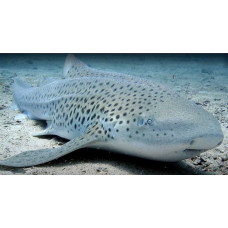Latin name
Stegostoma tigrinum
Other names
Stegostoma tigrinum
Identification
The body of the Zebra Shark is cylindrical, with five protruding longitudinal ridges on the skin (in adults). The head is broad and somewhat flattened. The gill slits are small; there are 5 pairs. The spatula is large. Nostrils with short antennae. Mouth moderately large, teeth poorly differentiated, with central apex and two lateral teeth; 28-33 in upper jaw and 22-32 in lower jaw.
Features of fish fins
No spines on the fins. The first dorsal fin is larger than the second. The pectoral fins are rather large and broad, much larger than the pelvic fins. The pelvic fins are smaller than the first dorsal fin, but larger than the second, and about equal to or slightly larger than the anal fin. The caudal fin is very long, about half the total length of the shark, and has no lower lobe.
Fish colouring
Adults are yellow-brown with dark brown spots; the belly is pale. Juveniles (up to 70 cm) are quite different: they are dark with white spots and vertical stripes.
Distribution
Widespread in tropical and subtropical waters of the Pacific and Indian Oceans, sometimes found in the southern part of the Sea of Japan.
Habitat
Zebra sharks are found only in the intertidal zone. However, they live in a variety of habitats within this zone. The maximum recorded depth is no more than 203 feet (62 meters). However, most individuals prefer shallow depths. They are commonly found along the continental shelf.
Size
The shark can reach a length of 2.3 m, very rarely 3 m. Its weight is about 30 kg (65 lb). In the wild, they live for 25-30 years.
Behavior
Zebra sharks hide on the ocean floor all day, relying on their camouflage coloration. At night, they hunt. They make long seasonal migrations of up to 1,000 kilometers per year. They are usually solitary creatures, but sometimes gather in large groups.
Food and feeding habits
Zebra sharks feed mainly on mollusks, but also on crustaceans and small fish.
Reproduction
This species is an egg-laying shark. Its egg capsules are quite large (up to 17 cm in length), elongated and have horny appendages that attach them to the bottom.
Fishing
It is of little commercial importance, but is still caught throughout its range. Occasionally caught as bycatch; also caught by recreational fishermen.
Relationship with a person
This shark is not aggressive and does not pose a threat to humans (although it may bite if provoked). It tolerates captivity relatively well: it is often found in oceanarium and aquarium exhibits.
| Classification | |
| Phylum | Chordata |
| Class | Chondrichthyes |
| Squad | Orectolobiformes |
| Family | Stegostomatidae |
| Genus | Stegostoma |
| Species | S. tigrinum |
| Features | |
| Conservation status | Endangered |
| Habitat | Bottom |
| Life span, years | 30 |
| Maximum body weight, kg | 30 |
| Maximum length, cm | 300 |
| Sailing speed, m/s | No information |
| Threat to people | Edible |
| Way of eating | Predator |
Zebra shark
Tags: zebra shark




